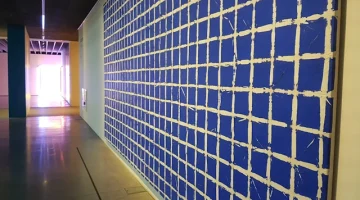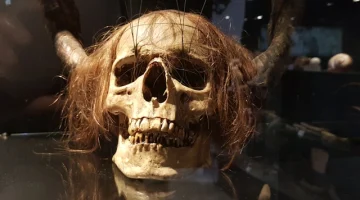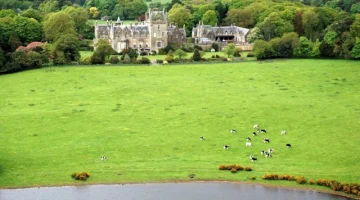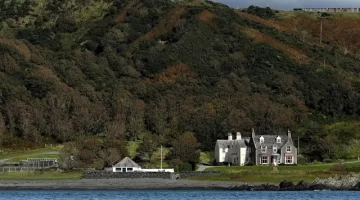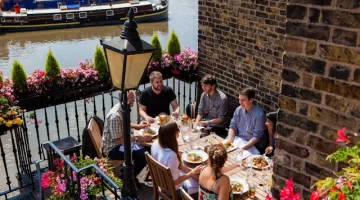Visiting Loch Ness
The Travel Pages visits Loch Ness in Scotland, including Urquhart Castle, Fort Augustus, the Caledonian Canal and of course looks for the Loch Ness Monster.

The Caledonian Canal connects Inverness to one of Scotland’s largest lochs, Loch Ness. Take a cruise on the loch to the impressive ruins of Urquhart Castle, watch the boats navigating the flight of locks at Fort Augustus, or visit Drumnadrochit to probe the mysteries of Nessie – better known as the Loch Ness Monster.
Getting There
It’s about an hour’s drive down the busy, winding A82 along the west side to Fort Augustus, 34 miles (55 kms) away. For a more leisurely drive, you can take the much slower, narrow B852 which hugs the shore on the east side of the loch (follow B862 from the city towards Dores). You can also visit Drumnadrochit and Fort Augustus by public bus, and there are numerous guided tours from Inverness, including Jacobite Cruises, which sail the Caledonian Canal into Loch Ness.

Sights and Attractions Around Loch Ness
Caledonian Canal
The Caledonian Canal is a 60-mile (97-km) waterway that runs from Fort William on the west coast to the Moray Firth at Inverness, providing an inland passage from sea to sea. It connects the freshwater lochs of the Great Glen, a geological fault that divides the Northwest Highlands from the Grampian Mountains. It was built to avoid the dangers of shipwreck on the long, stormy sea route around the north of Scotland.
Lochs Ness, Oich and Lochy make up 38 miles (61 kms) of the canal, but 22 miles (35 kms) had to be dug by hand. The route required 29 locks, each of which raise or lower the water level by 8 ft (2.4m). This amazing feat of engineering was designed by Thomas Telford. Work began in 1803 and took 20 years to complete. Though it was built for the trading ships and naval frigates of the day, passenger paddle steamers soon began operating on the canal, bringing tourism to the Highlands. Queen Victoria travelled the canal on the Gondolier in 1873.
Drumnadrochit
The tourist hub of Loch Ness is bustling with souvenir shops, tour coaches and a variety of accommodation. It also has two Loch Ness Monster visitor attractions.
Nessieland in the Loch Ness Lodge Hotel claims to believe in the monster and backs it up with an exhibition on the various sightings and scientific expeditions to find Nessie. lochness-hotel.com
The Loch Ness Centre and Exhibition in the Drumnadrochit Hotel presents a multi-media experience that aims to debunk the myth. lochness.com
Loch Ness Cruises will take you out on the Nessie Hunter, equipped with sonar, underwater camera and other equipment, to search for Nessie yourself. lochness-cruises.com
Fort Augustus
At the southern tip of Loch Ness, Fort Augustus is potentially the best place to see the Caledonian Canal in action. Here, boats make their way through an impressive flight of five locks, while the views from the bridges above are magnificent.

The little town is a peaceful place to stay and a good base for cruises on Loch Ness and walks in the surrounding countryside. A good place to find out about the network of local walking and cycle routes is at the Caledonian Canal Centre beside the locks, where there is a free exhibition about the building of the canal. scottishcanals.co.uk
Cruise Loch Ness, beside the swing bridge, offers day and evening scenic cruises, sightseeing excursions and a Nessie hunting trip. www.cruiselochness.com
Loch Ness
Loch Ness is 227 m (745 ft) at its deepest point. Its great depth makes it the largest Scottish loch by volume, containing some 7,447 million cubic m (263,000 cubic ft) of water. At 37 kms (23 miles) long and over 1.6 kms (1 mile) wide, only Loch Lomond has a greater surface area. Loch Ness’s murky appearance is caused by the high content of peat and mud in the water, furthering its reputation as Nessie’s lair.

Urquhart Castle
Sprawled across a rocky promontory above Loch Ness, these impressive ruins were once among Scotland’s largest and most important strongholds. The castle dates from the 13th century, and underwent many changes until it was blown up by departing government forces in 1692 to prevent it falling into Jacobite hands. The visitor centre contains interesting displays on life at the castle and artefacts found there. The 10-minute film is the best way to start your visit, with a delightful surprise at the end. historicenvironment.scot

More Information on Visiting Loch Ness
See the official website for Inverness and Loch Ness Tourism.
More Information on Visiting Loch Ness
See the official website for Inverness and Loch Ness Tourism.






